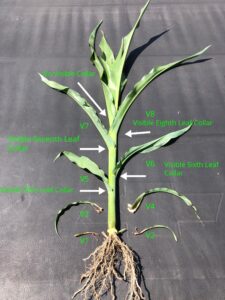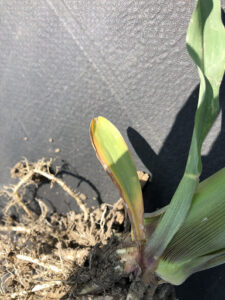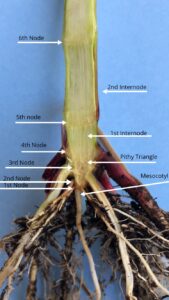Background
There are various ways to count growth stages of corn plants throughout the season. We use methods such as leaf over and corn height to decide when to come into fields and apply post emergence herbicides. Though what is the best method to assess corn growth in later vegetative stages? This becomes challenging when lower leaf senescence occurs and you can start to lose earlier developed leaves.
Leaf Collar Method With All Leaves
One of the most commonly used ways to consistently determine corn staging throughout the growing season is done by the leaf collar, or “V” method. When using the leaf collar method it is important to count all visible leaf collars starting from the first, rounded tip leaf to the uppermost visible leaf collar. As pictured in Figure 1, leaf collars can be distinguished as light yellow in appearance with a shirt-like collar at the base where the leaf blade meets the leaf sheath (True-Collar). Leaves still wrapped in the whorl that are not disclosed, do not count as a growth stage until the true collar becomes fully visible. Every true leaf collar is assigned a vegetative growth number. Therefore, since Figure 1 has eight visible true leaf collars, the plant is in V8 growth stage.

Leaf Collar Method With Missing Leaves
If the rounded tip leaf is not visible as pictured in Figure 2, you will have to use a modified method of determining the correct growth stage. The first step is to use a shovel to dig up a plant, ensuring that the stalk stays intact. After you’ve dug the plant, the next step is to use a pocket knife to split the base of the corn stalk open starting at the roots. After splitting open the corn stalk you should first look for the small inverted triangle, this contains the first four nodes (pithy triangle) (Figure 3). It gives the pithy triangle appearance because these nodes do not elongate and remain compressed. About ½ to ¾ of an inch above the inverted triangle there will be a white/yellowish line, this is the fifth node (attachment point of 5th collared leave, V5). The small whitish space between the pithy triangle (nodes 1-4) and node 5 is considered the first internode. After node 5 the length of the internodes increase, this is mainly reliant on air temperature, typically the length between node 5 and 6 is about an inch.
Now, to determine what growth stage the plant is at, find the leaf sheath that corresponds to the node. Typically the fifth node is used to start the counting process, therefore after finding the leaf sheath and collar that connects to the fifth node, continue to count leaves with visible true collars above that. For example, if there were 3 additional leaves with visible true collars above the leaf originating from the fifth node, the corn plant would be at the V8 stage. If the plant doesn’t have a good visual representation of the nodal lines or if you’re unsure, just select another plant and try again

What is the significance of knowing your corn growth stage?
So you count your corn plant and you have a V8 plant, so what? Well if you decide to stage several plants you can get a good indication on how uniform your crop is, which ultimately can be related to final yield. If you dig up a bunch of plants that are relatively close in growth stage you probably won’t be too worried. Though if you get a bunch of variability between plants, this might be a good showing that there could be underlying management/mechanical issues. These issues could be: Early planting cold stress, compaction issues, poor planter performance, fertilizer placement issues and unfit seed bed.

| Interesting Fact:
Each corn leaf originates from an individual node, the first four nodes remain compressed at the crown of the plant (pithy triangle). |
References:
Abendroth, L.J., R.W Elmore, M.J. Boyer, and S.K. Marlay. 2011. Corn Growth and Development. Iowa State Univ. Extension Publication #PMR-1009. https://store.extension.iastate.edu/Product/Corn-Growth-and-Development [URL accessed July 2020].
Nielson, R.L. (Bob). 2019. Determine Corn Leaf Stages. Corny News Network, Purdue Univ. [On-line]. Available at https://www.agry.purdue.edu/ext/corn/news/timeless/VStageMethods.html. [URL accessed July 2020].
Nielsen, R.L. (Bob). 2019. Use Thermal Time to Predict Leaf Stage Development in Corn. Corny News Network, Purdue Univ. [On-Line]. Available at http://www.kingcorn.org/news/timeless/VStagePrediction.html. [URL accessed July 2020].
Timmerman, A. (2020, June 01). Accurately Growth Staging Corn after Lower Leaf Loss and Implication for Post-emergence Herbicide Application. [On-Line]. Available at https://cropwatch.unl.edu/2020/accurately-growth-staging-corn-after-lower-leaf-loss-and-implication-post-emergence-herbicide